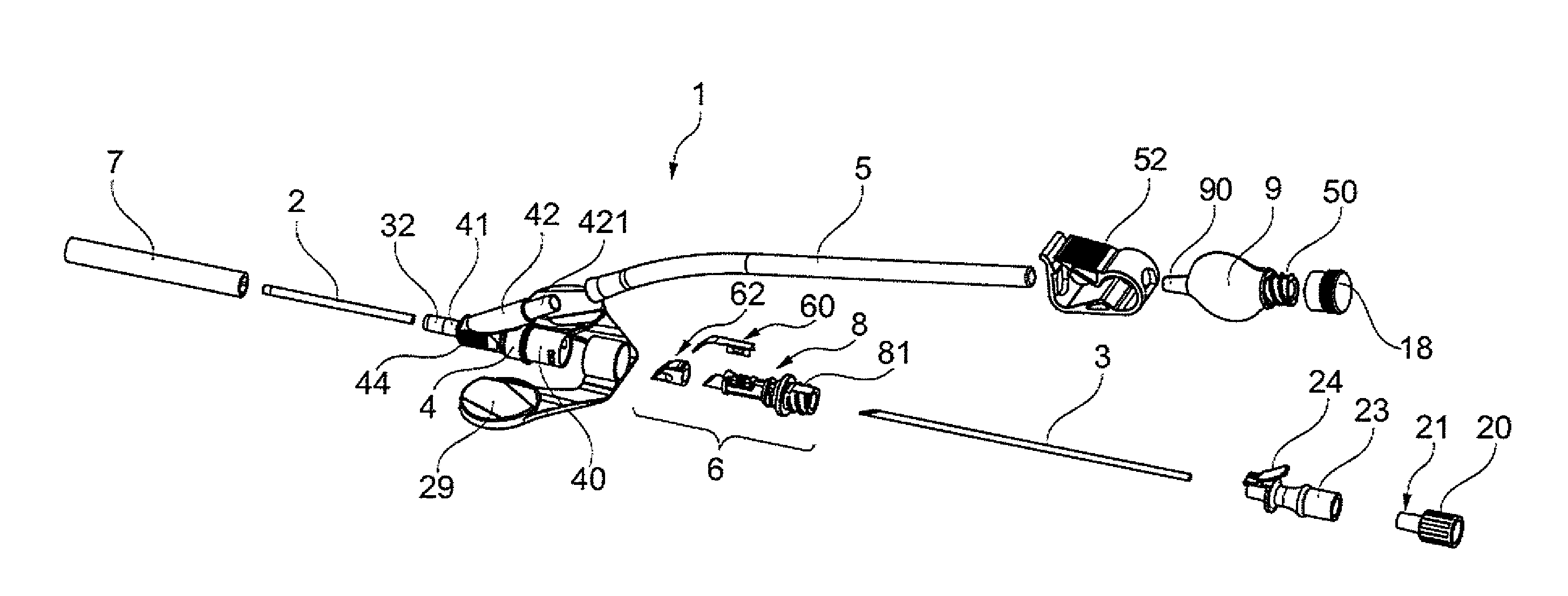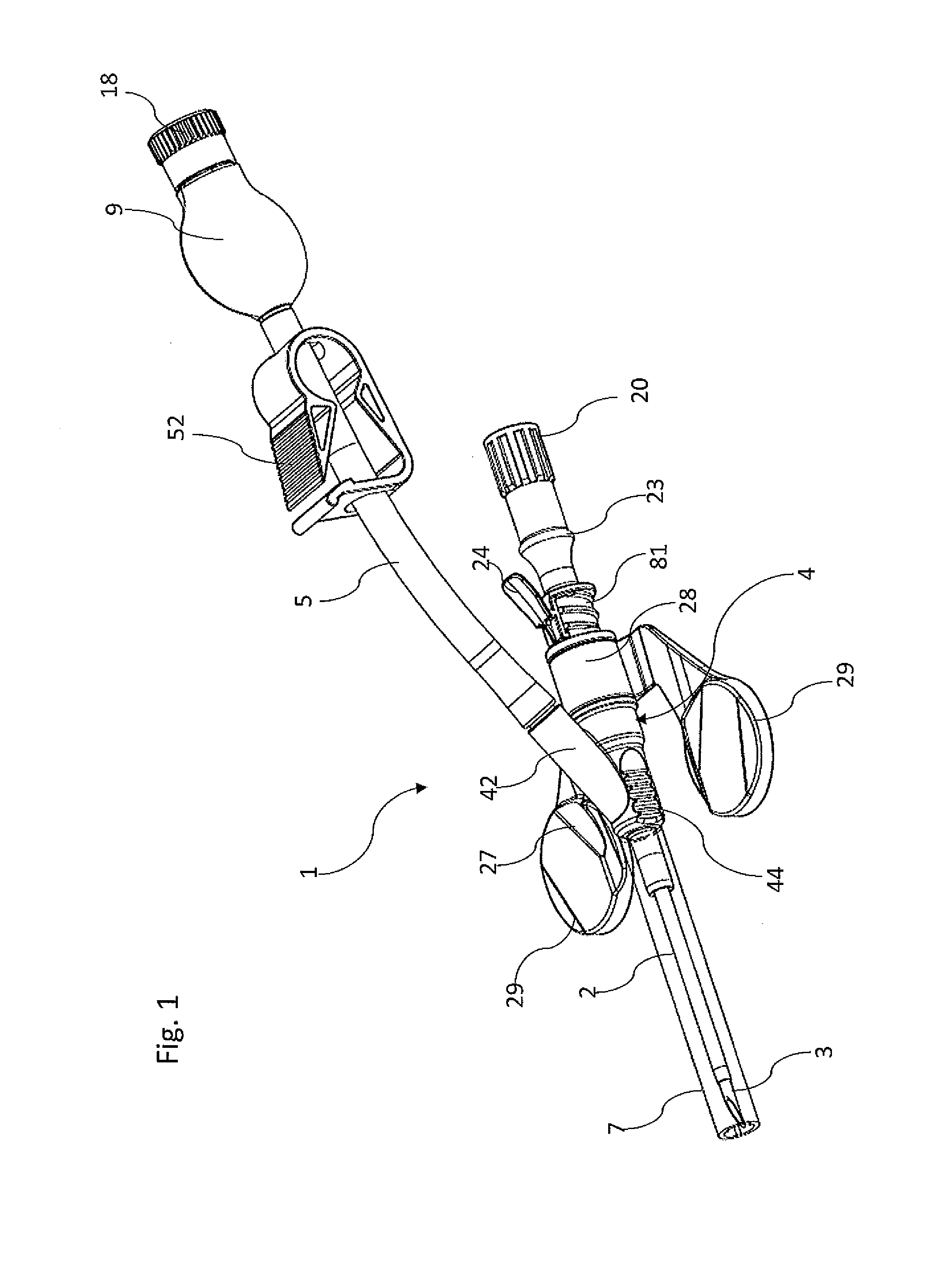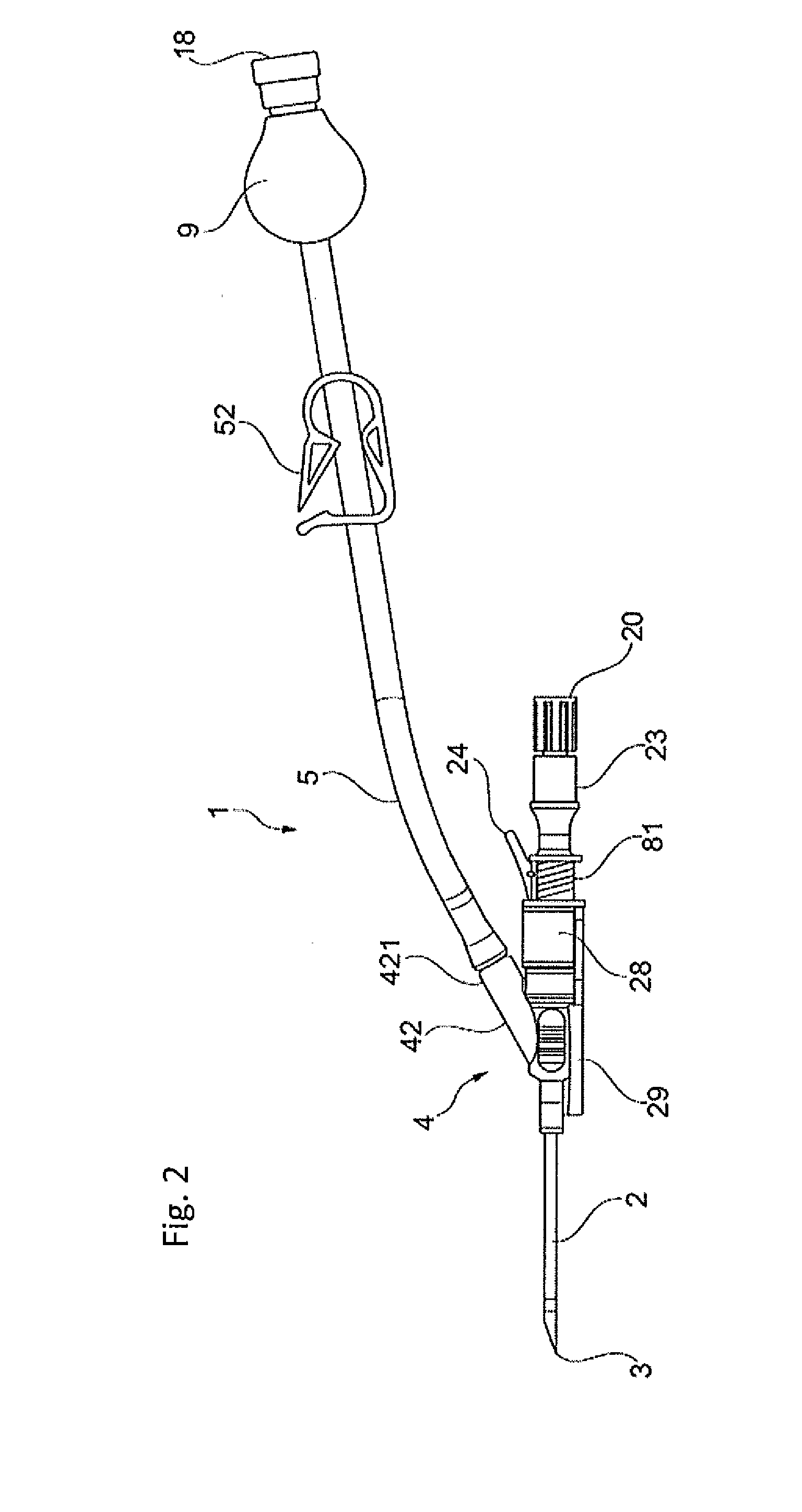Catheter introducer assembly
a technology of introducer and catheter, which is applied in the direction of catheters, other medical devices, guide needles, etc., can solve the problems of heavy and immediate outflow of blood, risk of blood leakage, and risk of blood contamination for health care providers, and achieve the effect of easy removal
Active Publication Date: 2014-08-07
NORDIC MED COM
View PDF8 Cites 15 Cited by
- Summary
- Abstract
- Description
- Claims
- Application Information
AI Technical Summary
Benefits of technology
The present invention provides an improved catheter introducer system, a safer and reliable valve / sealing arrangement for a catheter introducing assembly, a smooth media transfer system, and a robust and reliable construction that allows for easy withdrawal of a needle element. Additionally, this arrangement eliminates the risk of accidental entering of clotted blood into the blood circulation system and dialysis equipment.
Problems solved by technology
A common problem related to dialysis treatment (as well as to any situation involving insertion procedure for a catheter tube) is the risk of blood leakage, particularly when connecting the dialysis equipment to the fistula.
The large needle in combination with the high pressure in a fistula leads to the risk that blood from the circulation system often escapes, either when connecting the catheter to the fistula or during treatment, resulting in a leakage of blood which is of course highly undesired as it makes an already uneasy and exposed situation even worse for the patient, and also leads to a risk for blood contamination for health care providers.
As the blood pressure within a fistula is very high, penetration will lead to a heavy and immediate outflow of blood.
This naturally puts extremely high demands on the equipment / catheter assemblies which are intended to be used for transferring the blood from the patient to the dialysis equipment and again back to the patient.
In each of those situations there is a risks that the pressure difference inside the catheter hub compared to the ambient pressure leads to failure of the assembly components with leakage as consequence.
Another risk associated with extracorporal treatment is the occurrence of turbulence in the blood flow leading to risk of damage to the blood cells (hemolysis) which, as a result of the frequently reoccurring treatments that the patient is subjected to, gradually would degenerate the patient blood and in the long run represent a serious health risk.
Another problem which may pose a serious problem during a dialysis treatment is the risk of clotted / coagulated blood which sometimes is formed inside the catheter introducer assembly running the risk of entering into the dialysis equipment and / or into the patients.
A blood clot unintentionally entering a blood circulation system of a patient could lead to serious health risks and even be fatal.
However, retracting the cannula (often a metal needle) out of the instrument sometimes gives rise to undesired friction drag between the needle and the assembly wherefrom it is to be removed, which in its turn may lead to an inert or even irregular retraction motion which is of course a disadvantage: preferably connection of a catheter tube should be performed smoothly and without sudden interruptions.
However due to the specific circumstances related to certain treatments such as dialysis, according to our knowledge, no prior art arrangement has yet presented a fully satisfactory solution for connecting to a catheter assembly.
Existing catheter introducing assemblies are often quite complicated to handle, and may e.g. require at least two hands during the introducing procedure which makes the connection of the catheter laborious for the professional health care provider as well as it eliminates the possibility of self-treatment at home: the operation is simply too difficult to perform by oneself.
Method used
the structure of the environmentally friendly knitted fabric provided by the present invention; figure 2 Flow chart of the yarn wrapping machine for environmentally friendly knitted fabrics and storage devices; image 3 Is the parameter map of the yarn covering machine
View moreImage
Smart Image Click on the blue labels to locate them in the text.
Smart ImageViewing Examples
Examples
Experimental program
Comparison scheme
Effect test
second embodiment
[0045]FIG. 8A illustrates a valve assembly according to the invention,
third embodiment
[0046]FIG. 8B illustrates a valve assembly according to the invention, and
[0047]FIGS. 9A-B illustrate in sequence the closing of a valve assembly according to a second embodiment of the invention.
the structure of the environmentally friendly knitted fabric provided by the present invention; figure 2 Flow chart of the yarn wrapping machine for environmentally friendly knitted fabrics and storage devices; image 3 Is the parameter map of the yarn covering machine
Login to View More PUM
 Login to View More
Login to View More Abstract
The present invention relates to a valve assembly for sealing a through passage of a catheter introducing device, comprising a sealing unit having a movable closing member connected to a biasing means, and a seat member arranged with a sealing surface around the aperture of the through passage, wherein the biasing means is arranged to urge the closing member to sealably abut against the sealing surface, corresponding to a closed position, so as to prevent flow of fluid through the valve. The invention also relates to a catheter introducer assembly comprising a valve assembly.
Description
TECHNICAL FIELD[0001]The present invention relates to a device for conveying fluid media into or out of the body of a patient in a subcutaneous, intravascular or intramuscular way.BACKGROUND OF THE INVENTION[0002]Many medical situations and treatments are associated with the need for conveying fluid media into or out of the body of a patient. Access to a person's circulatory system, such as the cardiovascular or the cerebrospinal fluid system, is often achieved by means of introducing a catheter tube into the patient in a subcutaneous, intravascular or intramuscular way. Insertion of a catheter is done by means of a needle element, wherein the needle point is used for punctuating e.g. a vein and subsequently introducing the catheter before withdrawing the needle, leaving only the soft catheter tube which for instance may be connected to a source of fluid to be administered into or from the vein.[0003]A typical example of such medical situation is blood dialysis (usually hemo-dialysi...
Claims
the structure of the environmentally friendly knitted fabric provided by the present invention; figure 2 Flow chart of the yarn wrapping machine for environmentally friendly knitted fabrics and storage devices; image 3 Is the parameter map of the yarn covering machine
Login to View More Application Information
Patent Timeline
 Login to View More
Login to View More IPC IPC(8): A61M25/06A61M39/22
CPCA61M25/0606A61M2039/229A61M25/0097A61M39/227A61M2039/0666A61M1/3661A61M1/14A61M25/01
Inventor PUHASMAGI, ARNELUNDGREN, ANNE
Owner NORDIC MED COM
Features
- R&D
- Intellectual Property
- Life Sciences
- Materials
- Tech Scout
Why Patsnap Eureka
- Unparalleled Data Quality
- Higher Quality Content
- 60% Fewer Hallucinations
Social media
Patsnap Eureka Blog
Learn More Browse by: Latest US Patents, China's latest patents, Technical Efficacy Thesaurus, Application Domain, Technology Topic, Popular Technical Reports.
© 2025 PatSnap. All rights reserved.Legal|Privacy policy|Modern Slavery Act Transparency Statement|Sitemap|About US| Contact US: help@patsnap.com



